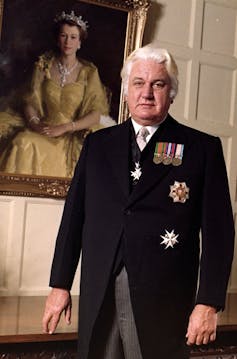Source: The Conversation (Au and NZ) – By Anne Twomey, Professor of Constitutional Law, University of Sydney
For more than four decades, the question has been asked: did the queen know the governor-general, Sir John Kerr, was about to dismiss the Whitlam government, and did she encourage or support that action?
The release of the “palace letters” between Kerr and the palace can now lay that question to rest. The answer was given, unequivocally, by the queen’s private secretary, Sir Martin Charteris, in a letter to Kerr on November 17 1975. He said:
If I may say so with the greatest respect, I believe that in NOT informing The Queen what you intended to do before doing it, you acted not only with perfect constitutional propriety but also with admirable consideration for Her Majesty’s position.
Certainly, Kerr had kept the palace up to date with the various developments in Australia. While governors-general usually communicate with the queen only three or four times a year during ordinary times, it is common during a crisis for updates on the political situation to be made every few days – particularly if there is a risk of the queen becoming involved or the exercise of a reserve power.
Read more: The big reveal: Jenny Hocking on what the ‘palace letters’ may tell us, finally, about The Dismissal
Drawing the palace into the crisis
In 1975, there were multiple issues that might have drawn the palace into the crisis.
First, there was the question of whether Kerr should exercise a reserve power to refuse royal assent to an appropriation bill that had been passed by the House of Representatives but not the Senate. Fortunately, Whitlam dropped this idea, so that controversy disappeared.
Then there was the question of whether state premiers would advise state governors to refuse to issue the writs for a half-Senate election, and whether Whitlam would then advise the queen to instruct the governors to issue the writs. This didn’t happen either, because Whitlam did not get to hold his half-Senate election. But the prospect was enough to worry the palace.

Next there was the issue of what to do with the Queensland governor, Sir Colin Hannah. Hannah, in a speech, had referred to the “fumbling ineptitude” of the Whitlam government. Hannah held a “dormant commission” to act as administrator of the Commonwealth when the governor-general was away.
Whitlam, contrary to the advice of both the Department of the Prime Minister and Cabinet and the Attorney-General’s Department, advised the queen to remove Hannah’s commission to be administrator.
Separately, the Queensland opposition petitioned for Hannah to be removed as governor, but that required the advice of British ministers, as Queensland was still in those days a “dependency” of the British Crown.
So the palace had to juggle advice on Hannah from two different sources.
A race to the palace
Another pressing question was what should be done if Whitlam advised Kerr’s dismissal. Kerr’s letters more than once referred to Whitlam talking of a “race to the Palace” to see whether he could dismiss Kerr before Kerr dismissed him.
Kerr saw these “jokes” as having an underlying menace. Kerr knew he didn’t have to race to the palace – he could dismiss the prime minister immediately. But he also knew, after Whitlam advised Hannah’s removal merely for using the words “fumbling ineptitude”, that Whitlam wouldn’t hesitate to act.

The letters also show Kerr had been told that while the “Queen would take most unkindly” to being told to dismiss her governor-general, she would eventually do so because, as a constitutional sovereign, she had no option but to follow the advice of her prime minister. This would inevitably have brought her into the fray in an essentially Australian constitutional crisis.
Kerr explained in a letter after the dismissal that if he had given Whitlam 24 hours to advise a dissolution or face the prospect of dismissal, there was a considerable risk Whitlam would advise the queen to dismiss Kerr. He wrote:
[…] the position would then have been that either I would in fact be trying to dismiss him whilst he was trying to dismiss me, an impossible position for The Queen, or someone totally inexperienced in the developments of the crisis up to that point, be it a new Governor-General or an Administrator who would have to be a State Governor, would be confronted by the same implacable Prime Minister.
Advice from the palace
The letters reveal much of Kerr’s thinking, but little from the palace. Charteris rightly accepted the reserve powers existed, but they were to be used “in the last resort and then only for constitutional and not for political reasons”.
Charteris stressed the exercise of such powers was a
heavy responsibility and it is only at the very end when there is demonstrably no other course that they should be used.
This did not give Kerr any “green light” or encouragement to act. No-one suggested to him that the end had come and there was no other course to be followed. That was for Kerr to judge, and rightly so, because the powers could only be exercised by him – not the queen.
Whether the end had come and there was no other course is essentially what continues to be debated today. Should Kerr have waited? Should he have warned Whitlam? Was another course of action available?
All of these questions may justly be debated. But, no, the queen did not direct Kerr to dismiss Whitlam. He was not encouraged to do so. He was only encouraged to obey the Australian Constitution, which is something we all should do.
– ref. ‘Palace letters’ show the queen did not advise, or encourage, Kerr to sack Whitlam government – https://theconversation.com/palace-letters-show-the-queen-did-not-advise-or-encourage-kerr-to-sack-whitlam-government-142376







